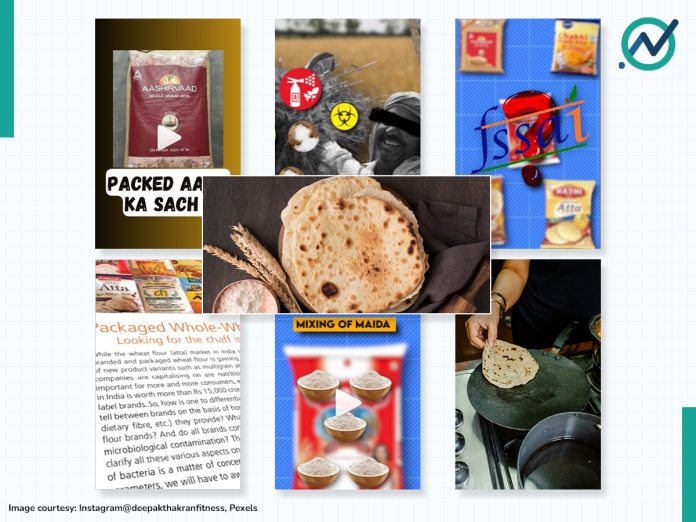Authors
Think of homemade food and your mind will invariably go to the Indian staple — chapatis. The round and fluffy flatbread, considered a healthy and nutritious necessity in daily diets across Indian households, is the force behind the booming packaged-atta industry that is also breaking ground in the rural market. Till the late 90s, whole wheat flour (atta) was mainly home-ground or milled through local chakki mills in India, before branded packaged wheat flour emerged, becoming rapidly popular in the country.
But is packaged atta safe and a “healthy” alternative for home-ground flour? One social media influencer says otherwise, even going to the extent of calling it a health hazard.
Adulteration, inadequate regulations, and poor-quality grains, among other health risks, surround the packaged atta sold in India, according to Deepak Thakran’s Instagram reel, uploaded on August 5, 2023, titled the “Truth behind your packaged atta”. The video has 3,662 likes and 1,301 shares.
To counter this “health hazard”, Thakran sounds a ringing endorsement for homemade whole wheat flour, saying, “The simple solution is to get wheat ground from a nearby mill, ensuring it lasts no more than 15 days. If possible, opt for stone grinding, which uses less heat and preserves the nutritional value of the flour.”
Exaggerated claims?
Thakran, who goes by the Instagram handle @DeepakThakranFitness, is one among the new wave of “fitness and nutrition influencers”, who “exposes” the dangers of the processed food industry. Although several of these influencers do provide valuable information, the content they share is frequently found to be exaggerated, fatalistic, and misleading.
For instance, take Brian Johnson, popularly recognised as the American fitness influencer “Liver King.” He asserted that his well-developed physique was an outcome of an “ancestral” diet centred around consuming raw animal organs, particularly the liver. Subsequently, it was revealed that Johnson’s remarkable physical appearance was not solely because of his dietary choices, but a result of significant steroid usage. This revelation led to an apology video that garnered 2.6 million views on YouTube.
With a substantial following of over two lakh on Instagram, Thakran identifies himself as an “NSCA-CSCS, ACE Coach.” He uses his social media platforms to review food items, endorse Ayurveda, and dispense fitness advice. “The purpose of this channel is to build a community around proper fitness practices and explain the science behind it. This is not a channel for people looking for short-term gains or hacks, but for people interested in building a fit and healthy lifestyle for life,” reads the description of his YouTube channel, clearly indicating that Thakran intends his advice to be followed long-term.
Thakran’s Instagram profile page reveals a focus on recognizable packaged foods found on supermarket shelves. In these videos, he emphasises on the potential health and nutritional risks associated with such products.
One of Thakran’s most viewed videos is his rating of India’s best packaged noodles, uploaded on December 25, 2022 and which has 610,377 likes. In the video, Thakran takes aim at Maggi noodles, pointing out that its ingredients, including maida, high sodium levels, palm oil, and trans fats, will cause indigestion, heart blockages and high blood pressure. Similarly, his video criticising Parle-G biscuits, terming it “unhealthy” on account of its ingredients, has clocked 21,000 likes. In another video, uploaded on December 24, 2022, Thakran claims that refined oil is a ‘conspiracy by foreign companies’ to “destroy Indian culture and make us sick” as it is akin to poison.
The health enthusiast has around 150 videos where he doles out nutrition and fitness tips. A prominent feature of his videos is the inclusion of cash giveaways — a well-known marketing tactic employed by influencers to increase following, engagement, and reach.

In Thakran’s “advisory” against packaged atta, he points out five “health risks”:
- Inadequate regulations from the Food Safety and Standards Authority of India (FSSAI) – the government agency that monitors food industries in India – claiming that it focuses mainly on labelling and basic information.
- Companies adulterate the product with maida to cut costs, while preservatives and bleaching agents are added to increase shelf life.
- Companies use poor-quality grains.
- Urea and harmful chemicals are used during cultivation of wheat by farmers.
- Packaged atta is old and according to Ayurveda, one should only eat fresh produce or in this case, freshly ground atta.
We received this video on our Whatsapp tipline (9999499044) with a request to fact-check the claims.
Inadequate regulations: Any grain of truth?
According to food technologist Subhaprada Nishtala, the FSSAI regulations on packaged wheat flour include eight quality parameters, along with detailed physical, chemical, and microbial safety parameters, such as tests for 20 pesticide residues, seven heavy metals, and two naturally occurring toxins. “All licensed food product manufacturers, labellers, and packers are mandated to have these tested once in six months in NABL-accredited, FSSAI-notified labs and upload these reports to FoSCoS (Food Safety Compliance System),” says Nishtala, who was the former president of the Association of Food Scientists and Technologists (I), Mumbai.
Dr R Sai Manohar, a retired senior principal scientist from the Central Food Technological Research Institute (CFTRI) who has conducted multiple studies on whole wheat flour and wheat-based products, says that Thakran’s video is “very much misleading” and is far from the truth, while also showing FSSAI in poor light. On the claim of inadequate regulations, Manohar says, “This [the claim] is very much unacceptable. Whole wheat flour and wheat flour for different end products have various specifications from FSSAI. Indian laws are very stringent.”
Nishtala also states that FSSAI standards include a test for the maximum level of uric acid, which is 100ppm, in line with other global regulations.
Experts: Wrong to think that packaged wheat flour/atta is adulterated with maida
Is maida (refined flour) added to atta? No, states Nishtala, who says, “It is wrong to think that maida manufacturing is cheaper than whole wheat atta. There is no appreciable difference in cost, and hence adulteration with maida is not beneficial to the companies. No additives are permitted in packaged atta.”

We noticed he used some images of known packaged-atta brands in his video and although they were blurred, we could discern the names. A glance at the ingredients of these brands shows that wheat is the only ingredient.
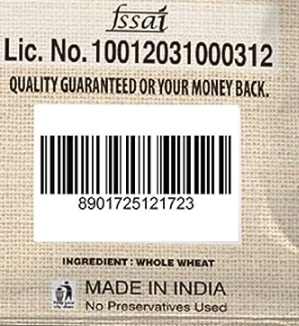

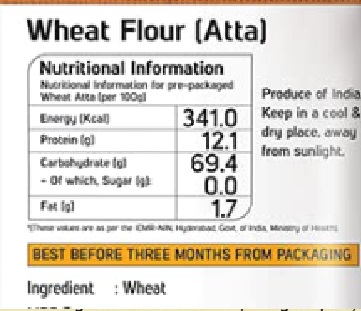
(From left) List of ingredients as seen on the back of a 5kg pack of Aashirvaad Atta, Pillsbury Chakki Fresh Whole Wheat Atta, and Fortune Chakki Fresh Atta.
Manohar concurs, saying that the video clearly shows the influencer’s lack of knowledge and expertise in wheat flour, whole wheat flour and the law implementing authority (FSSAI). “Maida is produced from wheat in a roller flour mill, whereas whole wheat flour (atta) is produced by a chakki mill. Cleaned wheat is used to produce either wheat flour or whole wheat flour. The extraction is around 70% in the case of wheat flour produced by roller flour mills, whereas it is around 97% in the case of the whole wheat flour produced from chakki mills.”
Bad-quality grains and use of harmful chemicals?
Responding to the claim that bad-quality grains are being used by companies, while urea and harmful chemicals are used during the cultivation of wheat, Manohar says, “The end product’s quality depends on the raw materials used to produce the product. Whole wheat flour’s quality depends on the quality of wheat used and on the processing conditions. Depending on the end product’s use, different quality wheats are selected with controlled specifications. I do not agree with the video, which states that bad-quality grain is being used. Any farmer uses fertilisers and chemicals to grow more and for better yields. It is a well-known fact that one must pay a premium price to have natural foods without the usage of fertilisers.”
Manohar says that preservatives and bleaching agents are used only while producing end products from wheat flour for specific purposes. “And all these bleaching agents and preservatives are well permitted by FSSAI in different end products. These are well-documented and are also well-regulated. No one uses a bleaching agent in whole wheat flour that reduces the golden-brown colour of the end product. If you mix wheat flour with whole wheat flour, the colour-grade value reduces. The consumer will not like the whiteish end product. Moreover, the ash content reduces and it is very easy to detect adulteration,” he says.
The Ayurvedic perspective
According to Dr Manas Ranjan Hota, a Delhi-based Ayurveda doctor and lecturer, Ayurveda always advocates the consumption of freshly prepared food. “Comparing wheat and its flour form, the nutritional value will stay longer in wheat as it is in its natural state. When it is crushed to powder, its natural integrity is disturbed. So, it will lose its nutritional value faster. There is a concept of Agni in Ayurveda. Every food item has its respective Agni. The level of Agni in the foodstuff is responsible for its digestibility after consumption. When natural integrity is manipulated, then Agni is also distorted. So its digestibility also is reduced. So it is advisable to consume food made out of freshly prepared flour. Earlier consumption is better,” said Dr Hota, adding that food made out of flour is called Pistanna in Ayurveda. “It is very heavy to get digested so one with a weak digestive system or suffering from any kind of digestion issue should avoid Pistanna,” says the doctor.
Interestingly, Patanjali Ayurved, an Indian multinational conglomerate co-founded by Ayurveda proponent Baba Ramdev, sells packaged atta.
No harm, reveals govt study
Back in 2017, the department of consumer affairs undertook a market research, which it published in its Consumer Voice report, to identify the popular and regular-selling brands of packaged whole wheat flour (atta) across the country. Thakran uses an image of the report in his video, stating that according to his research, packaged atta was found to have some deficiencies, following which we looked up the report.
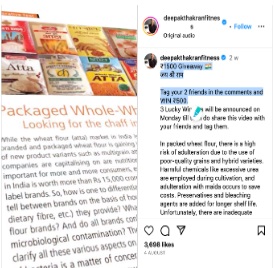
Screengrab of Thakran’s reel (above) and a screengrab of the Consumer Voice report (right).
All the 10 brands selected for testing and covered in this particular report were evaluated and graded as per their overall performance based on comprehensive laboratory results. All 10 brands, which included Pillsbury, Nature Fresh among others passed the physical and chemical tests, while no traces of pesticide, lead and aflatoxins (toxins produced by mould) were detected.
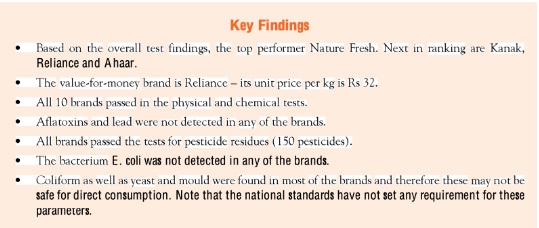
Based on the research findings, no traces of the E. coli bacterium were identified across any of the brands investigated. The study did highlight the presence of yeast and mould in most brands, indicating that these products might not be suitable for direct consumption. However, the research pointed out that the current national standards do not establish specific requirements for these aspects. This implies that the brands are in adherence with the existing standards.
While the outcomes of this study could potentially advocate for increased regulation or the establishment of acceptable limits by the government, Thakaran’s interpretation, as shared with his social media followers, is not entirely accurate, lacking in context and therefore could mislead people.
Not first bit of fake news: FSSAI quashes rumour that packaged atta contains plastic
In the past, a number of individuals on social media shared videos where citizens conducted kitchen experiments suggesting that packaged flour “contained plastic”. These experiments resulted in the dough gaining an elastic and sticky consistency.

One such brand which faced these allegations was ITC’s Aashirvaad Atta, who categorically rubbished the claim, while the FSSAI in the myth busters section on its website stated, “Wheat flour naturally contains 2 proteins – Glutenin – for elasticity & Gliadin- for raising of dough. In the presence of water, these 2 proteins bond together to create an elastic network of protein called gluten strings. Gluten is the rubbery mass that is left when wheat flour dough is washed with water & this is maliciously referred to as plastic.”
JP Tandon, former director of wheat research, Indian Institute of Wheat and Barley Research, had in a Youtube video, uploaded by Aashirwad, clarified that the rubbery mass is gluten and that the allegations of the flour containing plastic are completely false. “If gluten is not formed in the atta made from wheat grains, then it means the grains are of bad quality,” Tandon says.
The Influencer Effect And Responsibility
In a video uploaded on April 10, 2023, a visibly upset Thakran, says that he is considering to stop posting advisories and withdraw the old ones as several big companies (he names Dabur and Pepsico) had served defamation notices to him. “These companies are just looking to make profits. The big food-monitoring agencies like FDA and FSSAI, who establish the rules and regulations, are the ones letting us down. They consider every ingredient as safe, adjust with the big companies, do not strengthen the regulations, which is how the companies exploit the loopholes in the rules to their advantage…The real power lies in us by educating ourselves on how to read labels and recognise harmful ingredients,” says Thakran, as he ends the video with a question for the viewers to ponder. He further urges users to introspect whether big organisations, companies, political parties benefit from keeping us healthy or in making us sick that we are forced to be admitted to hospitals that drain our money.
Thakran, however, has posted several videos offering nutrition and health tips after this video.
Newschecker reached out to Thakran for his response to the comments by the experts, but has received no response till the time of publishing this article. We will update this webpage with his reply if we receive a response.
The experts’ responses to Thakran’s claims serve as a reminder that it’s advisable to approach nutrition and health guidance from the majority of social media influencers with a degree of scepticism. Viewers should be cautious not to be swayed by seemingly straightforward and easy-to-follow tips. Health care, say experts, is not black and white, which means that real advice tends to be less enticing, littered with disclaimers and warnings and not promising of any real results.
However, it’s not all bad news when it comes to health and wellness influencers. Earlier this year, nutritionist Revant Himatsingka, known as Foodpharmer on Instagram, initiated a discussion by asserting in a reel that Bournvita’s marketing was misleading consumers (mostly children and their parents) with its “health drink” label.
In response, Bournvita’s parent company Cadbury issued a legal notice, prompting the influencer to remove the reel and issue an apology. However, this incident sparked a valuable debate among scientists, dieticians, and the general public about the composition of Bournvita and similar so-called “health drinks.” The debate emphasised that the “high sugar content” of these drinks often outweighs the touted benefits.
Himatsingka, 31, reportedly found support from unexpected quarters. The Nutrition Advocacy in Public Interest India (NAPi) a think tank comprising independent experts in epidemiology, human nutrition, community nutrition, paediatrics, medical education and administration, released a statement endorsing Himatsingka’s standpoint, stating that the “industrial formulation is inherently harmful”.
Social media influencers would do well to remind themselves that it is their social responsibility to fact-check information and substantiate their claims.
Ministry Lays Down Ground Rules
The government, too, has weighed in. The Department of Consumer Affairs, under the Ministry of Consumer Affairs, Food and Public Distribution, earlier this month released additional guidelines for celebrities, influencers and virtual influencers in the field of health and wellness. The rules aim to deal with misleading advertisements, unsubstantiated claims and ensure transparency in health and wellness endorsements, while guiding viewers on how to spot misinformation and half truths.
Like what you read? Let us know! If you would like us to do a deep dive on any social media influencer, or if you would like us to fact-check a claim, give feedback or lodge a complaint, WhatsApp us at 9999499044 or email us at checkthis@newschecker.in. You can also visit the Contact Us page and fill out the form.

